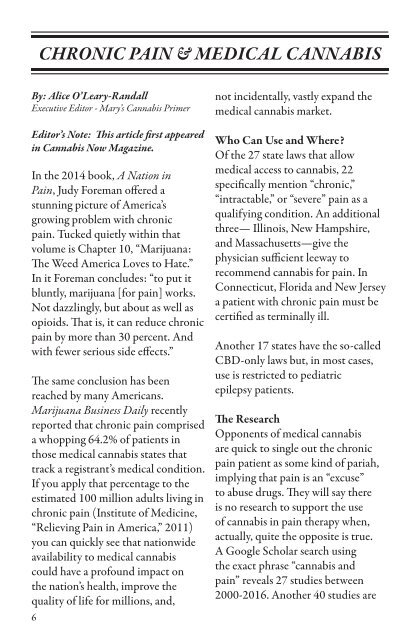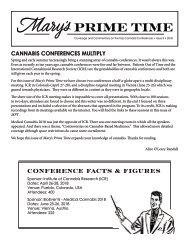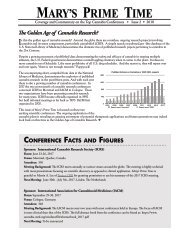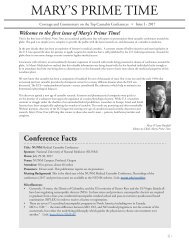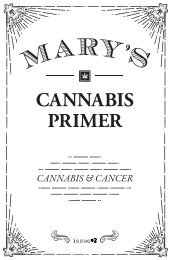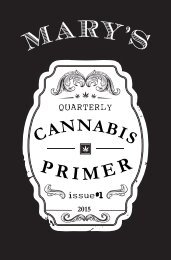#3: The Endocannabinoid System
Mary's Cannabis Primer is published as a resource for national and international education about the benefits of Cannabis. This issue focuses on the science of the Endocannabinoid System, and how THC affects the brain and the body.
Mary's Cannabis Primer is published as a resource for national and international education about the benefits of Cannabis. This issue focuses on the science of the Endocannabinoid System, and how THC affects the brain and the body.
Create successful ePaper yourself
Turn your PDF publications into a flip-book with our unique Google optimized e-Paper software.
CHRONIC PAIN & MEDICAL CANNABIS<br />
By: Alice O’Leary-Randall<br />
Executive Editor - Mary’s Cannabis Primer<br />
Editor’s Note: This article first appeared<br />
in Cannabis Now Magazine.<br />
In the 2014 book, A Nation in<br />
Pain, Judy Foreman offered a<br />
stunning picture of America’s<br />
growing problem with chronic<br />
pain. Tucked quietly within that<br />
volume is Chapter 10, “Marijuana:<br />
<strong>The</strong> Weed America Loves to Hate.”<br />
In it Foreman concludes: “to put it<br />
bluntly, marijuana [for pain] works.<br />
Not dazzlingly, but about as well as<br />
opioids. That is, it can reduce chronic<br />
pain by more than 30 percent. And<br />
with fewer serious side effects.”<br />
<strong>The</strong> same conclusion has been<br />
reached by many Americans.<br />
Marijuana Business Daily recently<br />
reported that chronic pain comprised<br />
a whopping 64.2% of patients in<br />
those medical cannabis states that<br />
track a registrant’s medical condition.<br />
If you apply that percentage to the<br />
estimated 100 million adults living in<br />
chronic pain (Institute of Medicine,<br />
“Relieving Pain in America,” 2011)<br />
you can quickly see that nationwide<br />
availability to medical cannabis<br />
could have a profound impact on<br />
the nation’s health, improve the<br />
quality of life for millions, and,<br />
6<br />
not incidentally, vastly expand the<br />
medical cannabis market.<br />
Who Can Use and Where?<br />
Of the 27 state laws that allow<br />
medical access to cannabis, 22<br />
specifically mention “chronic,”<br />
“intractable,” or “severe” pain as a<br />
qualifying condition. An additional<br />
three— Illinois, New Hampshire,<br />
and Massachusetts—give the<br />
physician sufficient leeway to<br />
recommend cannabis for pain. In<br />
Connecticut, Florida and New Jersey<br />
a patient with chronic pain must be<br />
certified as terminally ill.<br />
Another 17 states have the so-called<br />
CBD-only laws but, in most cases,<br />
use is restricted to pediatric<br />
epilepsy patients.<br />
<strong>The</strong> Research<br />
Opponents of medical cannabis<br />
are quick to single out the chronic<br />
pain patient as some kind of pariah,<br />
implying that pain is an “excuse”<br />
to abuse drugs. <strong>The</strong>y will say there<br />
is no research to support the use<br />
of cannabis in pain therapy when,<br />
actually, quite the opposite is true.<br />
A Google Scholar search using<br />
the exact phrase “cannabis and<br />
pain” reveals 27 studies between<br />
2000-2016. Another 40 studies are


